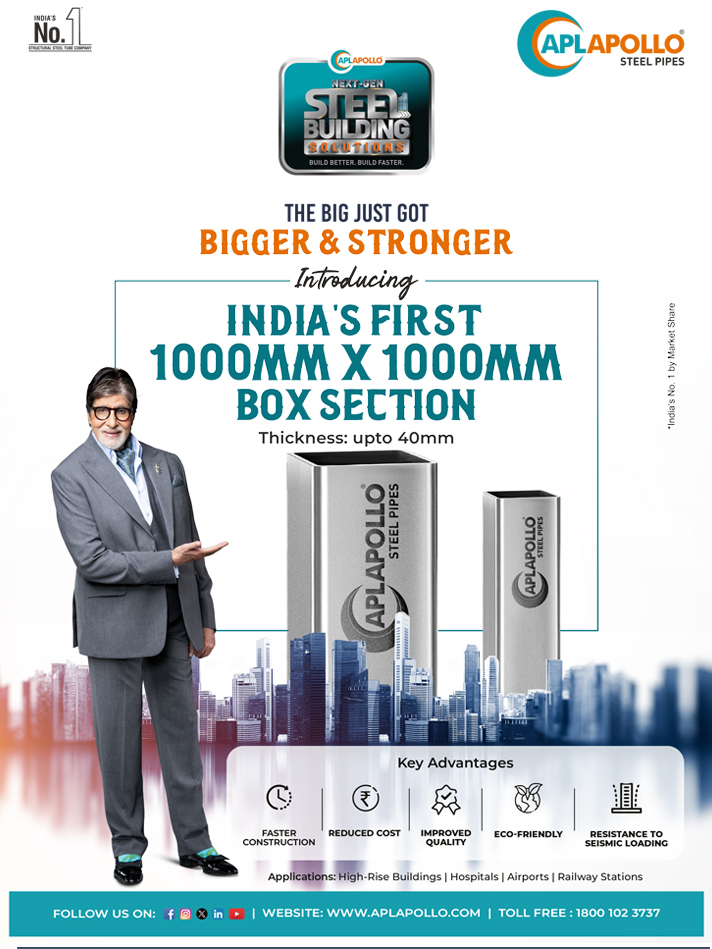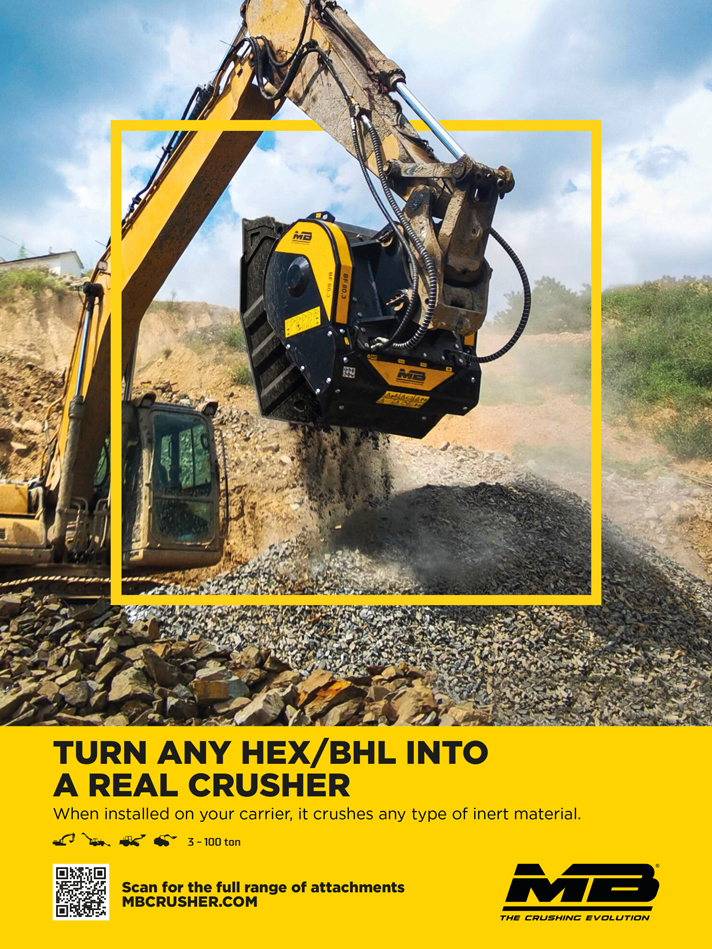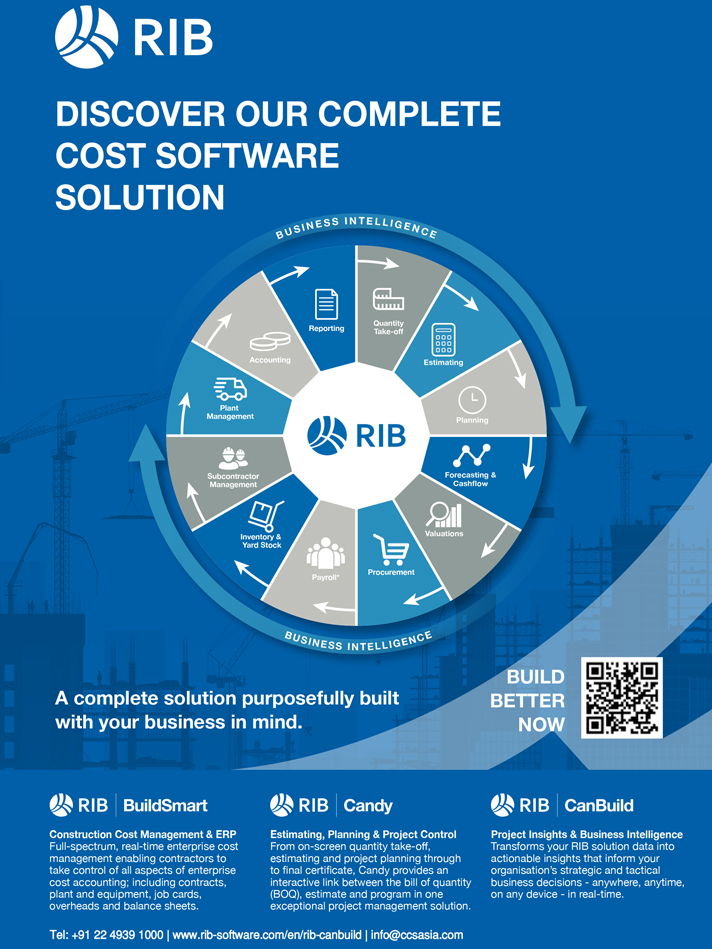
Ain’t A Smooth Ride
While it’s a known fact that infrastructure development of a country has a multiplier effect on its economy, yet it’s easier said than done! It requires years and sometimes decades of hard work, perseverance, government’s concerted thrust in the form of enabling policies and a multitude of innovative initiatives by the industry stakeholders. The last few years have already paved the way for steadfast progress on this front and we are witnessing winds of change in the way infrastructure development is shaping up across the country. This Cover Story tracks the development of one of highest priority industry verticals – ROADS and its allied segments such as construction machinery. While the road to progress is long & wide filled with myriad challenges, the green shoots of development serve as great positive signs and are offering a huge fillip to companies to drive this bandwagon on a fast trac, writes PRERNA SHARMA.
Infrastructural development plays a pivotal role in driving the overall growth of the economy. India made a crucial development in the field of infrastructure during 2022. Integrating with ‘Make in India’ and the production-linked incentives (PLI) scheme, the Central Government launched the National Infrastructure Pipeline to boost the development of the infrastructure sector. “As India completes 75 years of Independence, the nation is evolving into a prominent force in the global economic order. India is the world’s fifth largest economy and the prospect of steady progress in the coming years is bright. Here, the critical role played by infrastructure in economic growth cannot be overemphasised. Investing in high-quality infrastructure is crucial for accelerating economic growth and sustaining it in the long run,” the Economic Survey highlighted.
The country has been investing heavily in transportation, energy, and telecommunications sectors, and has made significant improvements in the availability and quality of these services. In order to achieve its target of US$5 trillion economy by 2025, the country has zeroed in on investing in the development of power plants, dams, bridges, highways, railways and urban infrastructure.
In Budget 2023-2024 the government has planned to significantly increase their capital expenditure by 33% (10 lakh crore), which makes up to 3.3 % of GDP. To improve the road network and connectivity of the nation, the government has planned to spend Rs.2.7 lakh crore on roads, out of which Rs.1.62 lakh crore is allotted to NHAI which is 21% higher than the previous year. In the year 2021-2022, NHAI successfully constructed 10,457 km of highways and awarded contracts of 12,731 km, which has improved the connectivity multifold.
The Ministry of Road Transport and Highways (MoRTH) has taken various initiatives to boost the road network across the country. In a bid to reach and connect the remotest part of the country, the government has taken several initiatives to augment the capacity of the National Highway infrastructure in India. In this context, the government has recently announced the construction of a National Highway (NH) in Nagaland and the development of an NH in Kerala. While this is just one of the projects being mentioned, the list of development is quite impressive. One of them being the recent inauguration of 119 km Bengaluru-Mysuru expressway project on NH-275, which is a 6-10 lane access-controlled highway developed at a cost of Rs.8,480 crore by the ministry of road transport and highway.
The Samruddhi Mahamarg is one of the most awaited expressways in Maharashtra. Also known as Mumbai-Nagpur Expressway, the 6-lane wide 701-km long expressway will reduce the travel time between the two cities to just 8 hours by reducing the 100 km distance. Although the first phase of the expressway from Nagpur to Shirdi, a distance of 520 km, was inaugurated in December last year, its remaining 181 km corridor will soon be operational.
With a speed limit of 150 km/h, the Samruddhi Expressway mahamarg project will be the fastest in the country. This calls for maximum concrete paving performance both in terms of output and quality to ensure drivers’ comfort and safety on their journey. Along a stretch of 701 km, 16 units of Wirtgen slipform paver SP 1600 were in operation to lay the concrete surface. Concrete is the ideal material for a gigantic project like this: it is cost-effective, extremely durable, and requires very little maintenance. Over a working width of 15 m, pavement quality concrete (PQC) in a depth of 310 mm was used. Proper reinforcement was done using an automatic dowel bar inserter and 3 longitudinal tie bar inserters. These make sure that cracks (which are invariably produced as a result of stresses and temperature fluctuations) are diverted into the concrete pavement in a controlled manner.
Enabling Growth
In the construction of roads and foundations, soil, gravel, concrete, or asphalt are compacted using road rollers, which are compactor-style engineering vehicles. The road roller market is growing at a rapid pace owing to the increasing construction activities across the globe. These machines offer high compaction performance and are highly productive. Moreover, road rollers require low maintenance and offer superior operator comfort, which is expected to drive the market during the forecast period.
The increasing demand for infrastructural development is one of the major drivers for the road roller market. With rapid urbanization and industrialization, there is a growing need for the construction of new roads, bridges, and other infrastructure projects. The need for better road surface quality is another major driver for the road roller market. Road rollers are used for compacting the asphalt on the road surface, which results in a smoother and more even surface. The increasing preference for green construction methods is another driver for the road roller market. Green construction methods are those that have a lower impact on the environment. Road rollers help reduce the carbon footprint of construction projects by reducing the emissions from construction equipment.
Ammann’s new ART 240 StV Pneumatic-Tyred Roller meets the world’s strictest emissions standards while excelling in soil and asphalt applications. The rollers offer high productivity and are outstanding fits on applications such as motorways, railways, airfields, industrial zones and residential areas. The compactors are versatile, with a ballasting system that offers weight ranges from 9 tonnes to 24 tonnes – unique to the market. Additional ballasting blocks are easy to add to the bottom of the machine frame via forklift. Machine weight can also be increased by adding ballasting materials such as sand, metal scraps, concrete or water inside the machine frame. Total available ballasting space is 3,7m3. A maintenance-friendly design minimises downtime. No tools are needed for daily inspections, and there is ground access to the main draining ports.
Alltech recently launched Asphalt Batch Mix Plant of Capacity 120 TPH in North Gujarat. This plant is designed to meet the growing demand for high-quality asphalt production in the region. With cutting-edge technology and an efficient process flow, this plant ensures seamless and cost-effective production of asphalt mix. The advanced features of this plant include computerized control systems, robust construction, and easy maintenance, making it a reliable and durable solution for construction needs. The plant’s capacity of 120 TPH makes it suitable for medium-scale projects and its location in North Gujarat offers easy access to major highways and construction sites. The company has even gone one step ahead and has made the entire process hi-tech by introducing CYBERMIX 1.1 software, which offers precise control over the asphalt mixing process, allowing customers to produce high-quality asphalt with maximum efficiency. With this software, companies can monitor and control every aspect of the asphalt mixing process in real-time, from the temperature and flow rate to the composition of the mix. They can even access detailed reports and analytics to optimize their production process and reduce waste.
With the government making large-scale investment plans for road network development, Sany’s asphalt machine range with powerful engines and reliable components is poised to be the ideal solution in various work environments/road construction. Sany Bharat has established a large network for after-sales support for their existing products, the brand plans to leverage this strength for the asphalt business line too. The newly launched machines are now available for end customers in the road construction industry in India and South Asia. Speaking on the occasion, Deepak Garg, MD, Sany Bharat and South Asia, said, “We are delighted to introduce our best-in-class asphalt machines for the very first time in India. These machines are designed in such a way that it gives maximum output with the optimum cost of operation. We believe this outstanding feature will be a key USP to staying ahead in this market.”
India is one of the fastest-growing economies in the world and due to rising road & infrastructural development initiatives to develop smart cities, towns, and villages, the market of asphalt pavers would witness substantial growth during the forecast period. Moreover, projects such as the golden corridor and Delhi to Mumbai industrial highway would accelerate the demand for asphalt pavers in the region. According to 6wresearch, India Asphalt Paver Market is expected to witness growth due to heavy expenditure on the construction & maintenance of roads and infrastructural projects, creating demand for asphalt pavers in the region during the forecast period. Additionally, rising demand from road traffic would require continuous construction and improvement of roads, in both rural and urban areas and is likely to flourish the India Asphalt Pavers market by the end of 2026.
P7320 ABG, a new paver from Volvo, is designed to provide customers working in 9-meter applications the ultimate in paving performance and profitability. Easy to set-up and with intuitive controls, operators can achieve optimum results in this paver and effectively pave up to 9-meters in a single pass. Durable, easy to service and powered by a CEV Stage IV compliant Volvo engine, this is the perfect paver for high-volume and multi-lane highway projects. Built with high-performance components, P7320 ABG is designed to boost productivity while lowering operating costs. Based on over 75 years of paving experience and innovative engineering, this paver delivers performance which lasts. With features including electric heating, screed extension quick coupling and easy-to-assemble guide plate system, companies can count on Volvo screeds to deliver a smooth, high quality surface. The intuitive layout guides operators through individual working functions, with the jog-wheel used to quickly select and adjust functions. Background illumination ensures a user-friendly operation both day and night.
To ensure the longevity of road surfaces, an optimal composite layer of the asphalt layers is essential. The SD2500CS PROTAC spray paver from Dynapac successfully applies the emulsion (pressure-sensitive adhesive) and asphalt paving in a single operation. This spray paver is primarily designed for two application areas. The first is for the application of thin asphalt surface layers using “Thin layer in hot paving on sealant”. The second is for road repair, as well as for new road construction and everyday asphalting tasks. The SD2500CS PROTAC sprays emulsion and applies asphalt in a single operation. In doing so, it increases operational efficiency while saving resources. What’s more, the road can also be opened faster traffic, thus reducing construction costs. Additionally, numerous measurements have confirmed that DSH-V surfaces have a noise reduction potential of about 5 dB(A). Moreover, the low thickness layer helps conserves resources, material use, time, and energy.
Road construction companies are equipped for the future with VÖGELE’s latest-generation SUPER 1900-5(i) and SUPER 2100-5(i) Road Pavers and AB 500 and AB 600 Extending Screeds. Highway Class pavers are perfectly at home whether on highways or handling other demanding large-scale projects. The SUPER 1900-5(i) manages pave widths between 2.55 m and 11.5 m, the SUPER 2100-5(i) up to 14 m. Both Dash 5 pavers are convincing products featuring a flexible, modular system which takes particular account of economy and sustainability as well as of ease of use and process automation.
Given the rise in raw material prices, economy is also becoming more and more of a factor in the success of road construction, which is why with its Dash 5 pavers, VÖGELE has ensured reduced setup times, improved logistics and increased machine availability. In addition to the new Paver Access Control (PAC) function, the intuitive and further optimised ErgoPlus 5 operating concept and the AutoSet Plus automatic function, optimised material handling, too, improves profitability. The new material handling control prevents load peaks and facilitates an optimum head of mix in front of the screed throughout the entire paving process. Whilst the benefits here are particularly obvious at relatively large pave widths, the Power Tunnel available as an option demonstrates its strengths primarily in paving jobs involving the extending screed without bolt-on extensions. The hydraulically extending limiting plates for the auger tunnel ensure an optimum level of material in front of the screed, even with hydraulic extensions fully extended. Retraction and extension of the Power Tunnel can be controlled together with screed width adjustment. Permanent availability without the need for assembly, combined with the optimum flow of material, save time and money and secure a high level of paving quality.
Caterpillar Inc. has expanded its paving products portfolio with the launch of new compact line of asphalt pavers and screeds. These standard 2.44 m size-class paver and screed combinations weigh in at 14 to 16 metric tonnes and include the Cat® AP400, AP455 Mobil-trac™, AP455 Steel Track, AP500, AP555 Mobil-trac, and AP555 Steel Track asphalt pavers as well as the SE47 VT and SE50 VT tamper bar screeds. They come equipped with features that excel in both urban and rural applications and can fit the needs of both large and small contractors. The compact size and small footprint combine with exceptional maneuverability for more opportunity to pave in confined areas such as narrow streets, small parking lots, and other urban-type applications. Cat pavers are equipped with an exclusive eco-mode feature that combines with automatic speed control to reduce fuel consumption. In most conditions, the engine can operate at a lower rpm and still deliver the required power to meet performance requirements. If needed, the engine will automatically adjust to a higher engine speed if certain load conditions are met.
Towards Sustainable Development Horizons
With a view to reduce the carbon footprint, the Ministry of Road, Transport and Highways is exploring options to construct national highways using Phosphor-Gypsum. The move aims to enhance durability and make construction more economical. India has the second-largest road network in the world. In this context, the National Highways Authority of India (NHAI) along with the Department of Fertilizers will soon take up field trials on its projects to achieve a circular economy in the use of Gypsum. The move is in line with the government’s commitment to using waste material in building ecologically sustainable National Highway Infrastructure in the country.
The Phosphor-Gypsum is a by-product of fertilizer production. A Phosphor-Gypsum road was first constructed by an Indian fertilizer company. Later the road was evaluated by CRRI (Central Road Research Institute) and based on their report, the Indian Road Congress (IRC) has formally accredited neutralized Phosphor-Gypsum waste material for road construction for a period of three years.
Use of plastic waste in road construction: In the past also, the NHAI has encouraged the use of plastic waste in road construction. Several studies have shown that roads built using plastic waste are more durable and sustainable. The roads made up of waste plastic also increase the life of the bitumen. The construction of a one km long four-lane highway requires around seven tonnes of plastic waste.
Use of fly ash in road construction: The NHAI authorities have already used ‘Fly Ash’ in the road construction project and in building flyover embankments. It is a fine residue of coal combustion in Thermal Power Plants (TPPs). Around 1.2 crore cubic meters of fly ash have been used in the construction of a 125 km long six-lane ‘Eastern Peripheral Expressway.
Innovations abound…
In yet another achievement towards self-reliance, the country developed the world’s first bamboo-made crash barrier and installed it on the Vani-Warora Highway in Vidarbha, Maharashtra. Crash barriers are installed on either side of a highway with an aim to prevent vehicles from falling out of the road network. It also keeps outside elements from entering into the highways. These are typically made of steel due to the strength the metal gives to these key infrastructure. Replacing steel barriers with bamboo crash barriers would be a very innovative move by the Centre to bring down fatalities in road accidents.
Union minister Nitin Gadkari called the development a “remarkable achievement” for India and its bamboo sector. “An extraordinary accomplishment towards achieving #AatmanirbharBharat has been made with the development of the world’s first 200-meter-long Bamboo Crash Barrier, which has been installed on the Vani-Warora Highway,” he said.
Talking about the barrier, the minister also conveyed that the bamboo-type used to make this crash barrier is Bambusa Balcoa, which has been treated with creosote oil and coated with recycled High-Density Poly Ethylene (HDPE). The crash barrier will act as the perfect alternative for steel and is environment-friendly, the minister added. The bamboo crash barrier, which has been named ‘Bahu Bali’ is about 200-meter long. In a statement, the Ministry of Road and Highways said that the crash barrier had undergone rigorous testing at various government-run institutions, including National Automotive Test Tracks (NATRAX) in Pithampur, Indore and was rated as Class 1 in the Fire Rating Test which was conducted at the Central Building Research Institute (CBRI) in Roorkee. The bamboo crash barrier had also been accredited by the Indian Road Congress. The statement released by the ministry also revealed that the recycling value of the bamboo crash barrier is 50-70%, while that of steel barriers is 30-50%.
With such interesting developments in place, road construction is set to be on a ROLL in the country!
Fast Facts
- The last decade has witnessed India building its road connectivity at a very fast rate and the national highway network is set to rise 37% in the next two years.
- As per the latest data from ministry of road transport and highways (MoRTH), highway construction in the country reached 7,803 km in FY23 upto January end.
- NHAI has awarded a total of 8,400 km of highways upto January this year against award of just 6,883 km in the same period last year. Increase in award is indicative of improving health of the sector with rising appetite for contractors to pick up projects.
- NHAI is also encouraging the use of waste plastic in the construction of road projects. Several studies have established that roads built using plastic waste are durable and sustainable. It also increases the life of the bitumen. The construction of one kilometer of a 4-lane highway helps in the disposal of around seven tons of plastic waste.














